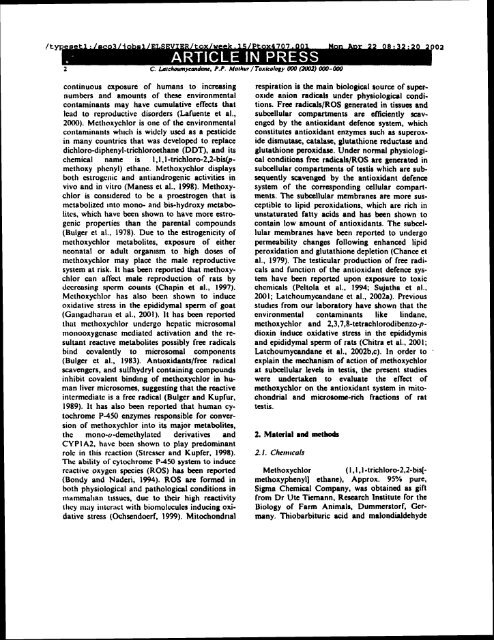ON TESTIS AND EPlDlDYMlS OF RATS - Pondicherry University ...
ON TESTIS AND EPlDlDYMlS OF RATS - Pondicherry University ...
ON TESTIS AND EPlDlDYMlS OF RATS - Pondicherry University ...
You also want an ePaper? Increase the reach of your titles
YUMPU automatically turns print PDFs into web optimized ePapers that Google loves.
continuous exposure of humans to increasing<br />
numbcn and amounts of thns cnvtronmcntal<br />
contaminants niay have cumulative efTects that<br />
lcad to reproductive disorders (Lafuentc et al.,<br />
2000). Mctlioiychlor is onc of the cnv~ronmentnl<br />
contamlnonts wli~clt as w~dcly urd as a pesticide<br />
in many countries that was developed to replau<br />
dichloro-diphenyl-tnchloroethane (DDT), and its<br />
chemical name is 1.l.l-trichloro-2.2-his@-<br />
mcthoxy phenyl) cthanc. Mcthoxychlor displays<br />
both ntrogcnic and antrandrogcnic activities in<br />
vivo and In vitro (Maness el nl.. 1998). Methoxychlor<br />
1s wnstdcred to be a proatrogcn that 1s<br />
mctabolired into mono- and bs-hydroxy melabohtcs,<br />
wh~ch have been shown to have more estrogenic<br />
properties than the parental compounds<br />
(Bulger el al., 1978). Due to the estrogcnictty of<br />
mcthoxychlor metabolites. exposure of either<br />
neonatal or adult organlsm to high doses of<br />
mclhoxychlor may place the male reproductive<br />
system at risk. It has been reported that methoxychlor<br />
can affect malc rcprodvction of rats by<br />
Jccrcnsina spc-rm counts (Chnpin ct al.. 1997).<br />
Mctlioxychlor has also been shown to inducc<br />
ox~dat~ve strm In the ep~didymal sperm of goat<br />
(Gnligudhar~a ct al.. 2001). It has bcen rcportcd<br />
th;it mcthoxyclilor undcrgo hcpatic m~crosomal<br />
nmnooxygcnax mcdiatcd actwallon and the resultant<br />
rcactlve metabol~tes possibly free radicals<br />
bind wvalcnlly to microsomal components<br />
(Bulger et al.. 1983). Ant$ox~dants/froe radical<br />
scavengers, and sulfhydryl containing compounds<br />
inhibat covalent bindlng of methoxychlor in human<br />
liver microsomes, suggesting that the rcastive<br />
intermediate is a frec radlcal (Bulgcr and Kupfur,<br />
1989). It has also been reported that human cy.<br />
tmhrome P-450 enzymes responsible for wnversion<br />
of methoxychlor into its major metaboliter,<br />
the mono-o-dcmethylatcd dcrivatlvn and<br />
CYPIA2, havc bcen shown lo play predomrnant<br />
role tn thas rcaction (Strcrxr and Kupfcr. 1998).<br />
Thc abklity of cylmhrorne P-450 system to mduu<br />
rcacuvc oxygcn spx~es (ROS) has ban reported<br />
(Bondy and Naderi. 1994). ROS are formed in<br />
both phys~ological and patholog~cal wnditions in<br />
mammalran ttssun, duc to lhcir high reactivity<br />
thcy s,;ty tmcrilct with hiomol~zuln inducing oxidat~ve<br />
stress (Ochxndocrf, 1999). Mitochondr~al<br />
respiration is the main bioloaical source of suoeror~dc<br />
anion radicals und~r-~h~siolo~iul conditions.<br />
F m radiFalsiROS generated in tissues mnd<br />
subcellular wmpMmonts are cfficicntly rcavcngcd<br />
by the antioxidant defence system, which<br />
co~ts(itutcs antioxidant enzymes such as supcror.<br />
ide dismutaac, &lase. xlutathione rcduclnse and<br />
glutathlonc peroxidase. Under normal physiological<br />
conditions ires radiulaIROS are generated in<br />
subcellular compartments of testis which are subsequently<br />
mvcngd by the antioxidant defence<br />
system of the corresponding cellular compartments.<br />
The suixzllular membranes an more sus-<br />
ceptible lo l~p~d pcroxidat~ons, which are rich in<br />
unslaturated fatty acids and has bcen shown to<br />
contain low amount of antiox~dants. The subcellular<br />
membranes have been reported to undergo<br />
pcrmeab~lity changes following enhanced lip~d<br />
pcroxidation and glutathione depletion (Chance ct<br />
al.. 1979). The testicular production or free radicals<br />
and function of the antioxidant dcfcna systcm<br />
have ken reported upon exposure to toxlc<br />
chcm~calr (Peltola ct sl.. 1994; Sujotha ct al..<br />
2WI. Latchoumvcandanc el al.. 2W2a) Prevaous<br />
stud~es from ou; laboratory havc shown that the<br />
cnvironmcntal wntamrnants lake Ilndanc.<br />
mcthoxychlor and 2.3.7.8-tetrachlorodibenzo.pdioxin<br />
indua oxidauvc suns in the epid~dymrs<br />
and eptdidymal sperm of rats (Chttra el al.. 2WI;<br />
Latchournycdndane el al., 2002b,c). In order to<br />
explain the mechanism of action of methoxychlor<br />
at suixzlluhr levels In testis, the present studies<br />
wen undertaken to evaluate the eNm of<br />
methoxychlor an the antioxidant systcm in mitochondrial<br />
and microsome-rich frlclions of rat<br />
testlS.<br />
2. Material and arthods<br />
Methoxychlor (I.l.I-lrichloro-2.2.b~~[~<br />
mcthoxyphenyl] cthanc), Appror. 95% purc,<br />
Sigma Chemical Company, was obta~ncd as gift<br />
from Dr Ute Ticmann. Rescarch institute for the<br />
Biology of Farm An~mals. Dummcntorf, Germany.<br />
Th~obarbitunc acid and malondialdchyde

















